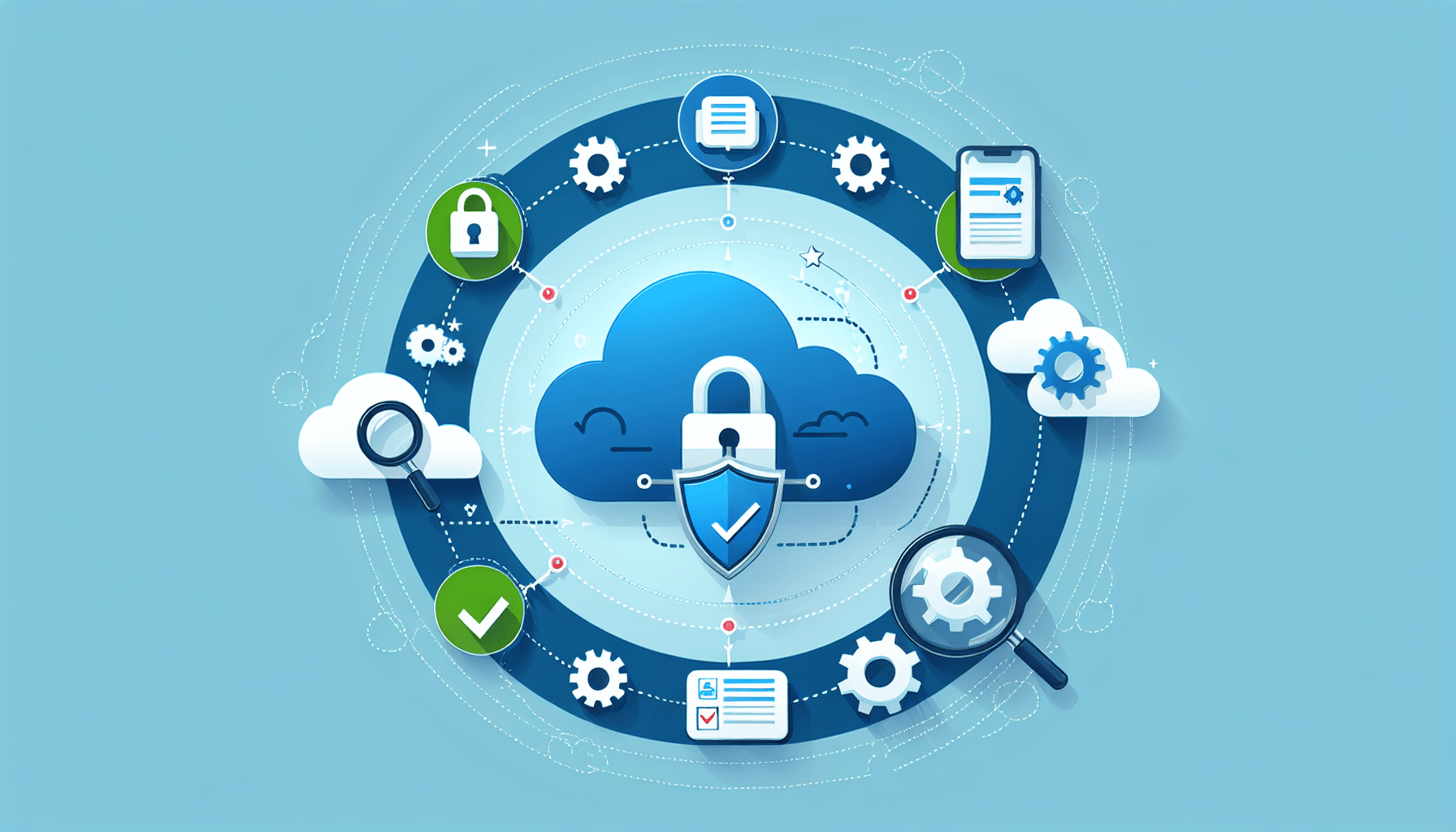In today’s fast-paced and ever-evolving world of technology, organizations are increasingly relying on DevOps processes to streamline software development and deployment. However, amidst this rapid pace of innovation, ensuring the security of cloud-based systems has become paramount. This article presents practical insights on how to effectively integrate cloud security assessments into DevOps processes, enabling organizations to identify and mitigate potential security risks, while maintaining the agility and efficiency that DevOps brings. By following these guidelines, you will be able to strengthen your organization’s security posture and confidently embrace the benefits of DevOps.
Understanding Cloud Security Assessments
What is a cloud security assessment?
A cloud security assessment is a systematic evaluation of the security controls and measures in place within a cloud environment. It involves assessing the security posture of cloud-based systems, identifying vulnerabilities and threats, and ensuring compliance with applicable regulations and standards. The assessment may include examining the cloud infrastructure, evaluating access controls, analyzing data protection measures, and assessing the effectiveness of security policies and processes.
Importance of cloud security assessments
Cloud security assessments are crucial for organizations using cloud services as they help to identify and mitigate potential security risks and vulnerabilities. By conducting regular assessments, organizations can ensure that their cloud infrastructure is secure and can protect valuable data and assets. Assessments also enable organizations to demonstrate compliance with industry regulations and standards, which is particularly important in highly regulated sectors such as finance, healthcare, and government. Furthermore, cloud security assessments provide insights into the effectiveness of an organization’s security policies and processes, allowing for continuous improvement and enhancement of security measures.
Benefits of Integrating Cloud Security Assessments into DevOps Processes
Enhanced security
Integrating cloud security assessments into DevOps processes provides enhanced security for cloud-based applications and infrastructure. By conducting assessments during the development and deployment stages, organizations can identify security vulnerabilities and address them early on. This proactive approach minimizes the risk of security breaches and ensures that the necessary security controls are in place to protect sensitive data and systems. Additionally, integrating security assessments into DevOps processes allows for continuous monitoring and improvement of security measures, keeping pace with evolving threats and risks.
Reduced vulnerabilities
Integrating cloud security assessments into DevOps processes helps reduce vulnerabilities in cloud-based systems. By conducting regular assessments, organizations can identify weaknesses and vulnerabilities in their cloud infrastructure and applications. This enables them to implement appropriate security controls and measures to mitigate these vulnerabilities effectively. Through ongoing assessments, organizations can stay ahead of emerging threats and vulnerabilities, ensuring that their cloud environment remains secure and resilient.
Compliance with regulations and standards
Integrating cloud security assessments into DevOps processes is essential for organizations that need to comply with industry regulations and standards. Cloud environments often handle sensitive data, and organizations must demonstrate their adherence to privacy and security requirements. By incorporating security assessments into the DevOps lifecycle, organizations can ensure that their cloud infrastructure and applications meet the necessary compliance obligations. This reduces the risk of non-compliance penalties and helps to maintain trust with customers, partners, and regulatory bodies.

Challenges in Integrating Cloud Security Assessments into DevOps Processes
Lack of awareness and understanding
One of the significant challenges in integrating cloud security assessments into DevOps processes is a lack of awareness and understanding. Many organizations may not fully understand the importance of security assessments or may underestimate the risks associated with cloud-based systems. This can lead to a lack of prioritization for security assessments and limited support from key stakeholders. Overcoming this challenge requires organizations to educate their teams about the benefits and importance of security assessments, ensuring that there is a shared understanding of the risks and the need for proactive security measures.
Resistance to change
Integrating cloud security assessments into DevOps processes may face resistance from teams and individuals who are resistant to change. DevOps processes are often focused on speed and agility, and adding security assessments may be perceived as slowing down development and deployment cycles. To address this challenge, organizations must clearly communicate the value of security assessments in terms of risk mitigation, compliance, and overall business resiliency. By emphasizing the importance of security as an integral part of the DevOps process, organizations can overcome resistance and foster a culture of security.
Complexity and scale of DevOps processes
The complex and scalable nature of DevOps processes can present challenges when integrating cloud security assessments. DevOps teams work in fast-paced environments, often employing numerous tools, technologies, and platforms. Ensuring that security assessments are seamlessly integrated into these processes without disrupting development cycles requires careful planning and coordination. Organizations need to invest in robust security tools and automation capabilities that can support continuous security testing and monitoring across the entire DevOps pipeline. Furthermore, clear guidelines and processes should be established to manage the scale of security assessments effectively.
Key Steps to Integrate Cloud Security Assessments into DevOps Processes
1. Educate the team
The first step in integrating cloud security assessments into DevOps processes is to educate the team on the importance and benefits of security assessments. This includes raising awareness of the potential risks and vulnerabilities associated with cloud-based systems and demonstrating the value of proactive security measures. Training sessions and workshops can be conducted to ensure that the team has a solid understanding of security best practices and the role they play in the DevOps process. By fostering a culture of security awareness, organizations can create a strong foundation for integrating security assessments into DevOps processes.
2. Define security requirements
Once the team is educated on the importance of security assessments, the next step is to define specific security requirements for the cloud environment. This includes identifying the types of data and systems that require protection, as well as understanding the applicable regulations and standards that must be complied with. The security requirements should be documented and communicated to the entire team, ensuring that all stakeholders are aligned on the necessary security controls and measures. This step helps to establish a clear roadmap for integrating security assessments into the DevOps process.
3. Implement security controls
After defining the security requirements, organizations need to implement the necessary security controls and measures to protect the cloud environment. This includes implementing access controls, encryption mechanisms, intrusion detection systems, and other security technologies. Security controls should be implemented based on industry best practices and tailored to the specific needs of the organization. The implementation process should be carefully planned and coordinated to ensure minimal disruption to the DevOps process. Regular testing and validation should be conducted to verify the effectiveness of the implemented security controls.
4. Automate security assessments
To achieve seamless integration of cloud security assessments into DevOps processes, automation is essential. Manual security assessments can be time-consuming and prone to human error, limiting their scalability and efficiency. By leveraging automation tools and technologies, organizations can streamline the security assessment process and ensure continuous monitoring of the cloud environment. Automated assessments can be integrated into the DevOps pipeline, providing real-time feedback on the security posture of the applications and infrastructure. This enables rapid identification and mitigation of vulnerabilities, reducing the risk of security breaches.
5. Integrate security testing into CI/CD pipeline
Integrating security testing into the continuous integration and continuous deployment (CI/CD) pipeline is critical for effective cloud security assessments. By embedding security testing into the development and deployment stages, organizations can identify and fix security vulnerabilities early in the process. This reduces the rework required and avoids delays in the release of applications or updates. Security testing should be included as part of the automated testing framework, ensuring that security assessments are performed consistently throughout the DevOps lifecycle. Regular monitoring and analysis of security metrics can further enhance the effectiveness of security testing in the CI/CD pipeline.

Selecting the Right Cloud Security Assessment Tools
Considerations for tool selection
When selecting cloud security assessment tools, several factors should be considered. Firstly, organizations need to evaluate the features and capabilities of the tools to ensure they align with their security requirements. The tools should support the specific cloud platforms and technologies used by the organization. Ease of use and integration with existing DevOps tools and workflows are also important considerations. Additionally, the scalability and performance of the tools should be assessed to ensure they can handle the size and complexity of the cloud environment. Finally, organizations should consider the cost-effectiveness of the tools and the level of support and documentation provided by the vendor.
Popular cloud security assessment tools
There are several popular cloud security assessment tools available in the market. Some of the notable ones include:
-
Amazon Inspector: A security assessment service that helps improve the security and compliance of applications deployed on the Amazon Web Services (AWS) platform. It offers automated security assessments and provides recommendations for addressing vulnerabilities.
-
Qualys Cloud Platform: A cloud-based security and compliance platform that offers a range of assessment services, including vulnerability management, compliance monitoring, and web application scanning.
-
Tenable.io: A comprehensive vulnerability management platform that provides continuous visibility into vulnerabilities and weaknesses in cloud-based systems. It offers extensive scanning capabilities and integrates with popular DevOps tools.
-
IBM Cloud Security Advisor: A security management platform that provides real-time visibility into the security posture of cloud-based workloads. It offers automated security assessments and recommendations based on industry best practices.
-
Synopsys Defender: A cloud-native application security solution that integrates security assessments seamlessly into the DevOps process. It supports static application security testing (SAST), software composition analysis (SCA), and dynamic application security testing (DAST) to identify and remediate vulnerabilities.
Organizations should evaluate these tools based on their specific requirements, considering factors such as ease of use, scalability, integration capabilities, and overall effectiveness in addressing cloud security challenges.
Best Practices for Integrating Cloud Security Assessments into DevOps Processes
Establish a security-first culture
To ensure successful integration of cloud security assessments into DevOps processes, organizations should establish a security-first culture. This involves prioritizing security and making it an integral part of the development and deployment lifecycle. All team members, from developers to operations personnel, should be trained on security best practices and encouraged to take ownership of security responsibilities. By fostering a culture that values security, organizations can ensure that security assessments are given the necessary attention and resources.
Implement security as code
Implementing security as code is a best practice that enables organizations to automate security measures throughout the DevOps process. By applying security controls and policies as code, organizations can ensure consistency and repeatability in security assessments. Security requirements can be defined using frameworks such as Infrastructure as Code (IaC) and Configuration as Code (CaC), allowing for automated deployment and configuration of secure cloud environments. This approach reduces the risk of human error and enables organizations to enforce security controls consistently across the entire DevOps pipeline.
Regularly update security policies and practices
Cloud security threats evolve rapidly, and organizations must keep their security policies and practices up to date to address emerging risks. Regularly reviewing and updating security policies based on industry best practices and compliance requirements ensures that the cloud environment remains protected against the latest threats. This includes updating access controls, encryption mechanisms, and intrusion detection systems. Additionally, organizations should conduct regular security assessments and penetration testing to identify any gaps in their security measures and address them promptly.
Monitor and analyze security metrics
Monitoring and analyzing security metrics is essential for assessing the effectiveness of cloud security assessments. Organizations should establish key performance indicators (KPIs) and metrics to measure the security posture of their cloud environment. These metrics may include the number of vulnerabilities identified, the time taken to remediate vulnerabilities, and the frequency of security incidents. By regularly reviewing these metrics, organizations can identify trends and patterns, allowing for continuous improvement of security measures.
Continuous training and skill development
To ensure the long-term success of integrating cloud security assessments into DevOps processes, organizations should invest in continuous training and skill development. Security threats and technologies evolve rapidly, and it is essential to keep the team updated with the latest security practices and tools. Organizations should provide regular training sessions, workshops, and certifications to enhance the team’s knowledge and skills in cloud security assessments. This ensures that the team remains competent in identifying and addressing security vulnerabilities and can effectively contribute to the organization’s security objectives.
Measuring the Success of Cloud Security Assessments in DevOps
Define measurable security objectives
To measure the success of cloud security assessments in DevOps, organizations need to define measurable security objectives. These objectives should align with the overall security strategy and the specific security requirements of the cloud environment. Measurable objectives may include reducing the number of vulnerabilities, achieving compliance with industry regulations, and minimizing the time taken to remediate security issues. By establishing clear objectives, organizations can track progress and evaluate the effectiveness of their security assessments.
Monitor and track security metrics
To assess the effectiveness of cloud security assessments, organizations should monitor and track relevant security metrics. This may include metrics such as the number of vulnerabilities detected, the time taken to remediate vulnerabilities, and the frequency of security incidents. Regular monitoring allows organizations to identify trends and patterns, enabling them to make data-driven decisions to improve the security posture of their cloud environment. It is important to establish a reporting mechanism that provides visibility into these metrics and allows for timely analysis and decision-making.
Regularly review and assess the effectiveness of security controls
Regularly reviewing and assessing the effectiveness of security controls is critical for measuring the success of cloud security assessments. Organizations should conduct periodic audits and assessments to evaluate the performance of security controls and ensure they are aligned with industry best practices and compliance requirements. This includes assessing the configuration of access controls, encryption mechanisms, and logging and monitoring systems. The findings of these assessments should be used to identify areas for improvement and implement corrective actions.
Case Studies: Successful Integration of Cloud Security Assessments into DevOps
Company A: Securing cloud-native applications
Company A successfully integrated cloud security assessments into their DevOps processes to secure their cloud-native applications. They implemented automated security testing tools within their CI/CD pipeline, enabling them to continuously assess the security of their applications from development through deployment. By establishing a security-first culture and providing comprehensive training to their DevOps team, they created a shared responsibility for security. The regular monitoring of security metrics allowed them to track their progress and identify vulnerabilities proactively. As a result, Company A significantly reduced the number of security incidents and achieved compliance with relevant regulations.
Company B: Achieving compliance through automated assessments
Company B, operating in the highly regulated healthcare sector, integrated cloud security assessments into their DevOps processes to achieve compliance with industry regulations. By using automated assessment tools, they could conduct regular security scans of their cloud infrastructure and applications. They implemented security controls as code, ensuring consistent and auditable security measures. Company B also regularly updated their security policies and practices and conducted penetration testing to identify vulnerabilities. Their commitment to continuous training and skill development ensured that their team had the necessary expertise to address emerging security challenges. Through their concerted efforts, Company B achieved compliance, demonstrating their commitment to protecting sensitive healthcare data.
Future Trends in Cloud Security Assessments and DevOps
Shift towards DevSecOps
A future trend in cloud security assessments and DevOps is the shift towards DevSecOps, which involves integrating security into every stage of the DevOps process. Rather than treating security as an afterthought, organizations are recognizing the importance of proactive security measures in the development and deployment of cloud-based systems. DevSecOps promotes collaboration between developers, operations personnel, and security teams, ensuring that security assessments are conducted continuously and seamlessly. This shift towards DevSecOps enables organizations to address security vulnerabilities early and fosters a culture of security throughout the organization.
Increased adoption of machine learning and AI
As the complexity and scale of cloud environments increase, the adoption of machine learning and artificial intelligence (AI) in cloud security assessments is expected to rise. Machine learning and AI can analyze vast amounts of data and identify patterns and anomalies that may indicate potential security threats. This enables organizations to detect and respond to security incidents in real-time, enhancing their ability to protect their cloud infrastructure and applications. Machine learning algorithms can also automate security assessment processes, reducing reliance on manual efforts and improving overall efficiency.
Focus on container security and serverless architectures
With the growing popularity of containerization and serverless architectures, there will be an increased focus on securing these environments. Container security assessments will become a crucial aspect of cloud security, ensuring that containers and their underlying infrastructure are configured securely. Likewise, serverless architectures will require specialized assessments to identify and mitigate security risks unique to this environment. As organizations embrace these technologies, integrating robust security assessments will be essential to ensure the protection of data and applications running in these environments.
Conclusion
Integrating cloud security assessments into DevOps processes is crucial for organizations looking to secure their cloud environments, reduce vulnerabilities, and achieve compliance. While challenges such as a lack of awareness, resistance to change, and the complexity of DevOps processes may arise, organizations can overcome them by educating their teams, defining security requirements, implementing security controls, automating assessments, and integrating security testing into the CI/CD pipeline. Selecting the right cloud security assessment tools, following best practices, and measuring success through defined objectives and metrics further enhance the effectiveness of these integrations. With future trends leaning towards DevSecOps, increased adoption of machine learning and AI, and a focus on container and serverless security, organizations can stay ahead in protecting their cloud environments. By prioritizing cloud security assessments and integrating them into the DevOps process, organizations can ensure the resilience and security of their cloud-based systems and applications.



